“A Guest is from God”
BY BONNIE NOBLE
One of Georgia’s best known national monuments, Kartlis Deda (Mother of Georgia), stands high above Tbilisi bearing a sword in one hand and a goblet of wine in the other. She represents Georgia’s protective and welcoming attitude towards guests.

Georgian people have a saying, “A guest is from God.” Welcoming strangers is a point of pride all across the country and they spare no effort in making their guests feel content, no matter if they are close relatives or if they just met you a few minutes ago.
The supra, a traditional Georgian feast, perfectly demonstrates this culture of hospitality. The reason for gathering and the menu may change, but the purpose of a supra remains the same – communal sharing and enjoying a meal together. We experienced first hand this wonderful Georgian culture of generosity and hospitality, along with several supras!
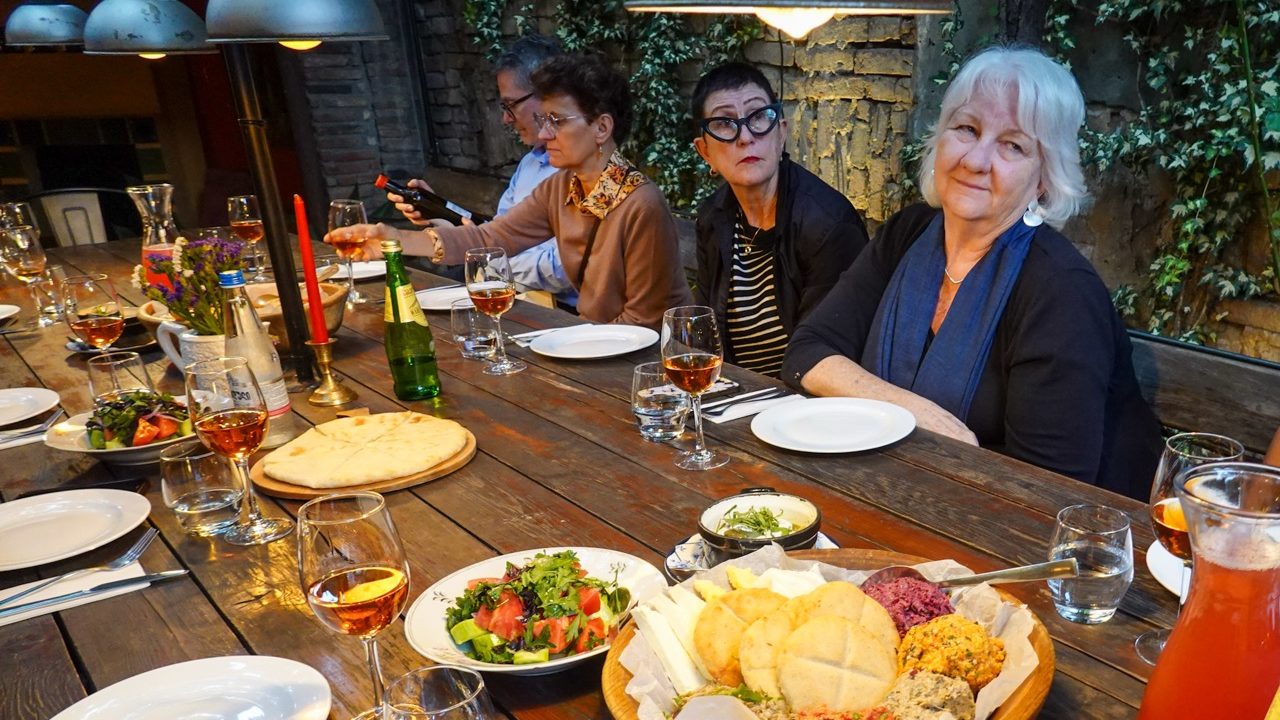
Extraordinary Hosts
The Kakheti region of Georgia, about two-hours by car to the northeast of Tbilisi, is Georgia’s main wine-producing region. In the town of Telavi, at the home of Gia and Lika Togonidze, we had an amazing supra that epitomized Georgian hospitality. Gia is an artist and a winemaker (Togo Winery). Lika is a fabulous cook.
When we arrived, we were greeted by Gia and Lika on a lovely terrace near the entrance to their home. After a warm welcome, we were escorted to the wine cellar where Gia ferments and stores his wine. A lovely table was set for us including several Georgian appetizers and Gia poured tastings of three different wines.
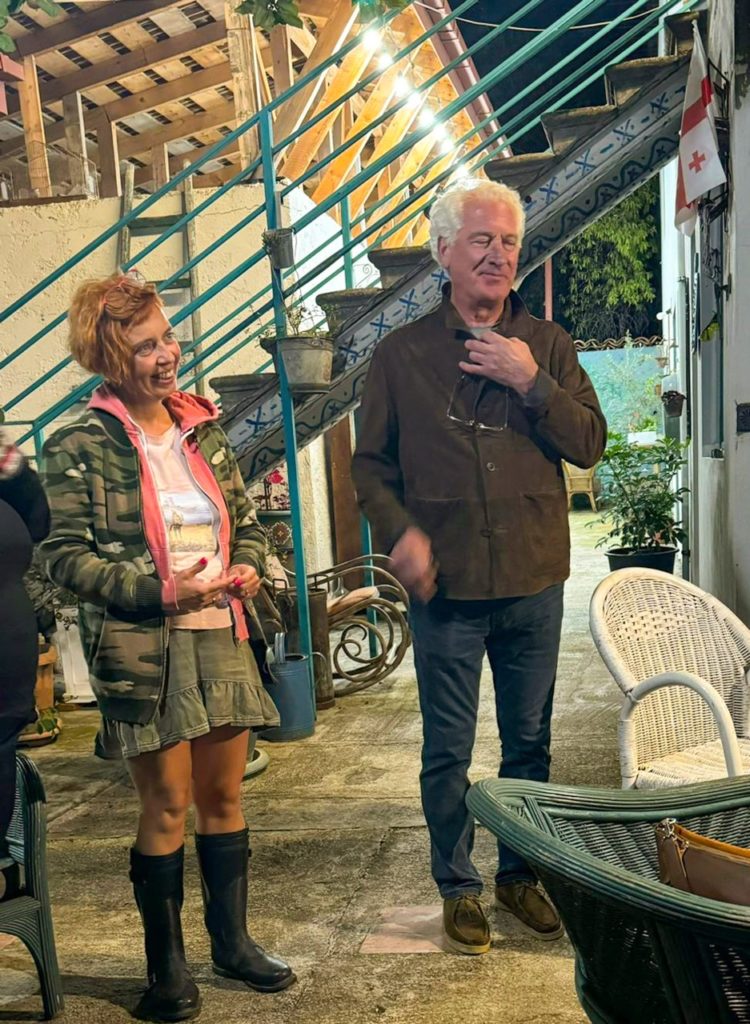
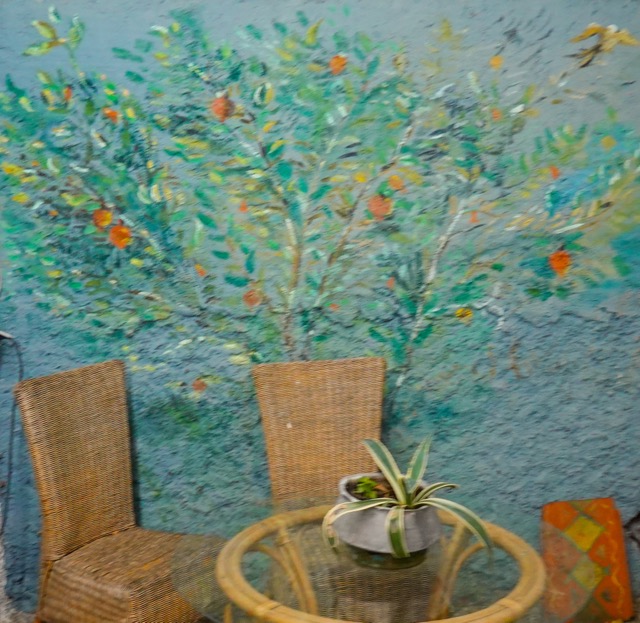
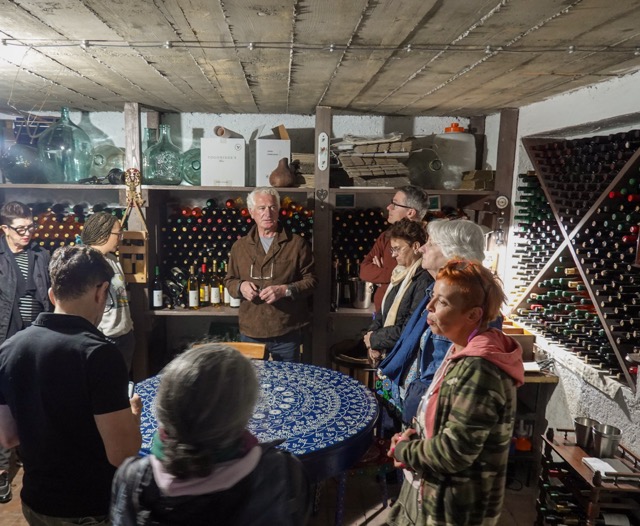
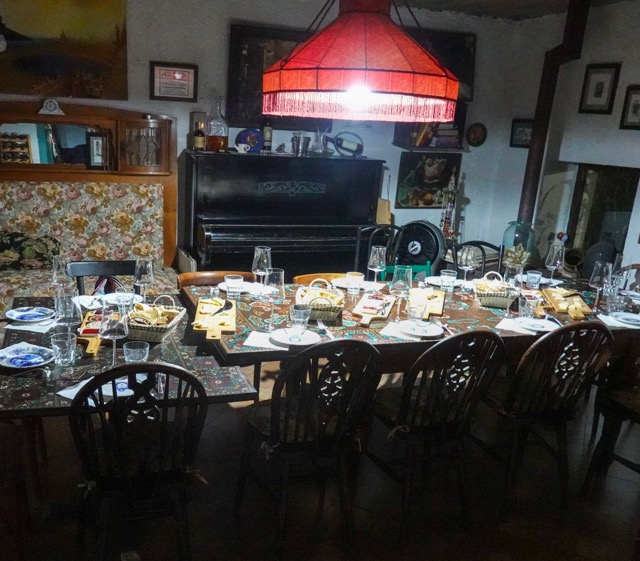
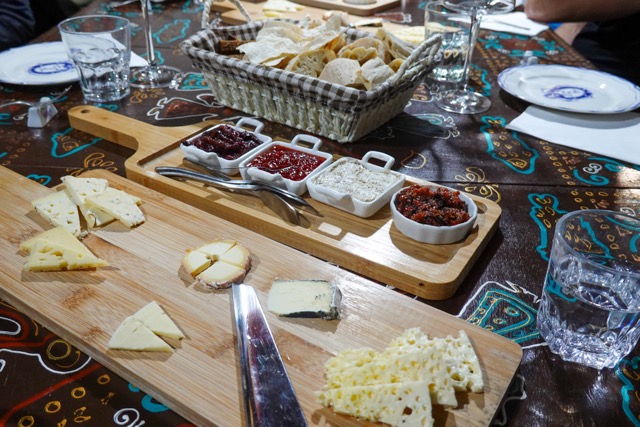
Next, we were escorted inside to their dining room for the main meal where another beautiful table was set and food started appearing soon after we were seated. Georgians don’t eat in courses, rather, food is placed on the table when it is ready and always served family style. The variety, quantity, and quality of the dishes Lika prepared for us was amazing.
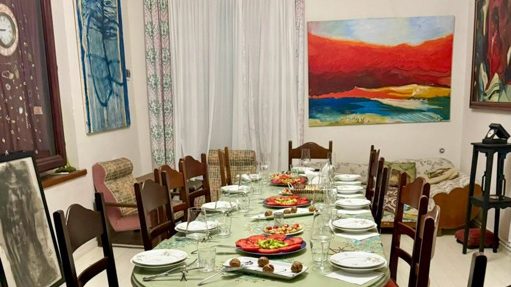
Georgians treat their guests much like royalty, offering food and drink every few minutes and insisting that you eat and drink as much as you possibly can. Since this was not my first supra, I kept reminding myself to be mindful about what I put on my plate and to carefully pace myself. At least my intentions were good.
The rules for a Georgian supra include several obligatory toasts by the host. It’s important to phrase these ritual toasts in a beautiful, poetic way and Gia did this perfectly. We tasted several more of Gia’s wines during our meal and each new wine required another toast.
After spending more than an hour at the dining table, we were escorted to an upper dining terrace where a third table was set for our dessert course. We were served some sort of creamy, honey, mousse like dessert that was absolutely delicious. Of course, this was accompanied by more wine and more eloquent toasts.
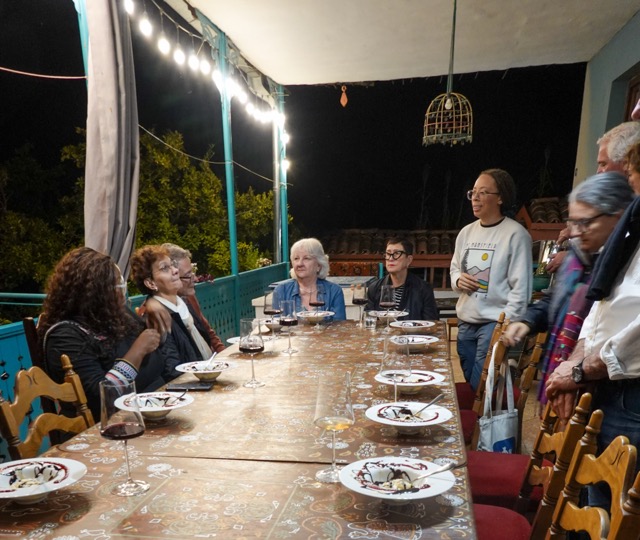
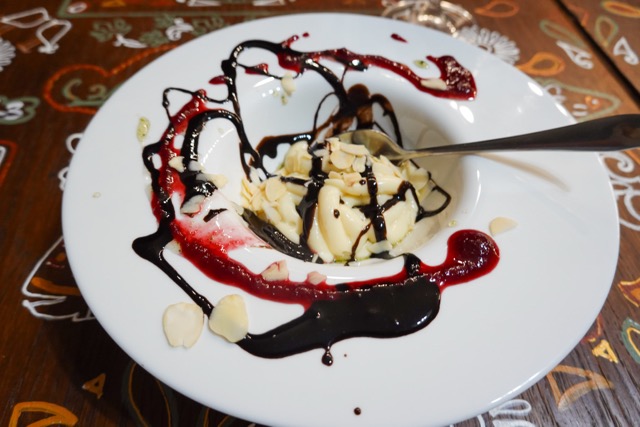
You might think the dessert course would conclude our supra. Nope. Next, we followed Gia downstairs to the chacha tasting room. Chacha is Georgia’s version of brandy made from grape pomace leftover from winemaking. It is clear and strong, ranging from 40-85% alcohol.
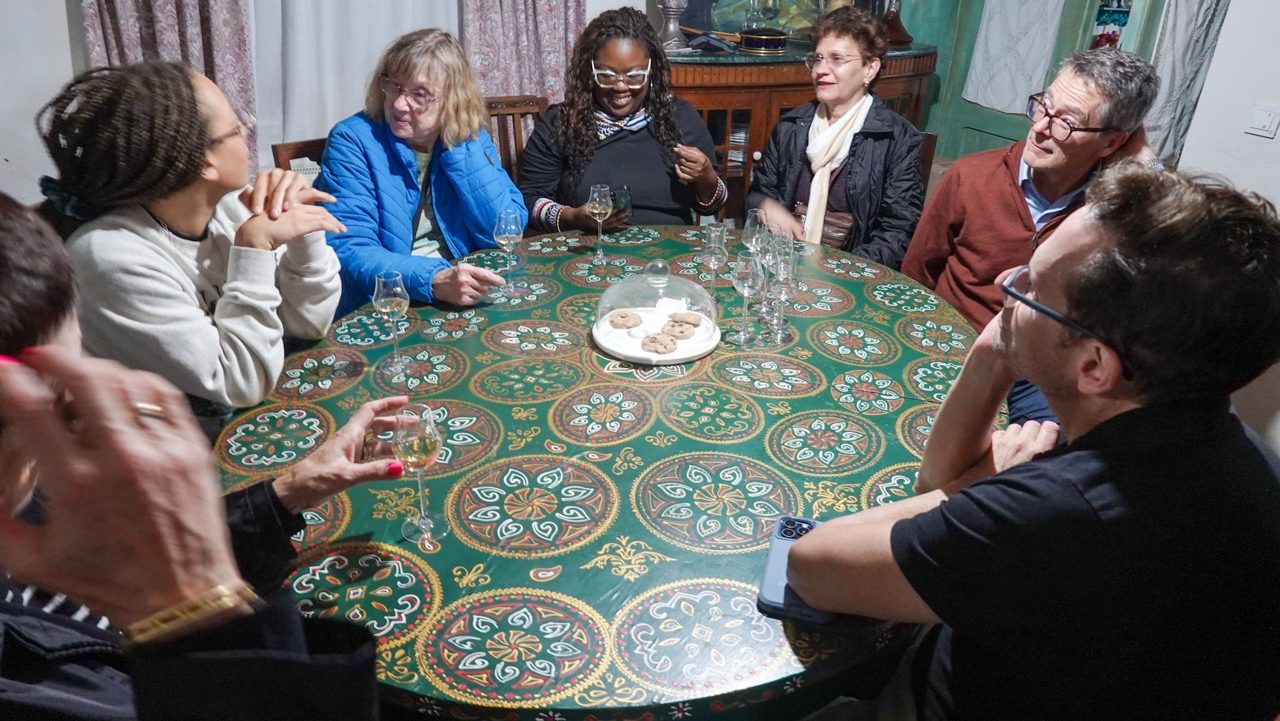
Georgians are some of the warmest, most welcoming, and laid back hosts you will ever encounter. Their generosity is matched by their genuine interest in others. They rarely take offense to anything, and drinking to excess is encouraged. Declining a drink, however, is frowned upon. We did our best to be gracious guests.
Georgia’s Future in the Balance
BY ED NOBLE
The evening has brought a soft breeze that perfumes the air with the harvest’s musky scent. It mixes pleasantly with the intoxicating aroma of wood smoked pork, filling the warmly lit dining patio. I find myself sitting across the table from an imposing man, our host for this feast. Salt and pepper hair and beard framing a handsome, open face, he is relaxed and confident as he shares his passion for winemaking and the traditions of his homeland. I am both charmed and intrigued. His eyes reveal fierce intelligence and intense pride, and as the wine flows the discussion begins to drift towards politics and Georgia’s future. Our tour guides, Kristo and Maka, both political activists, flank our host and it is quickly evident that their bond goes deep into the recent turmoil and unrest that seems to be Georgia’s endless fate.
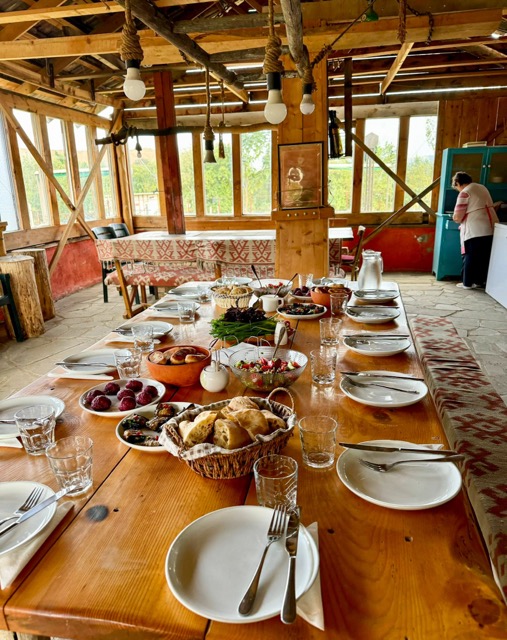
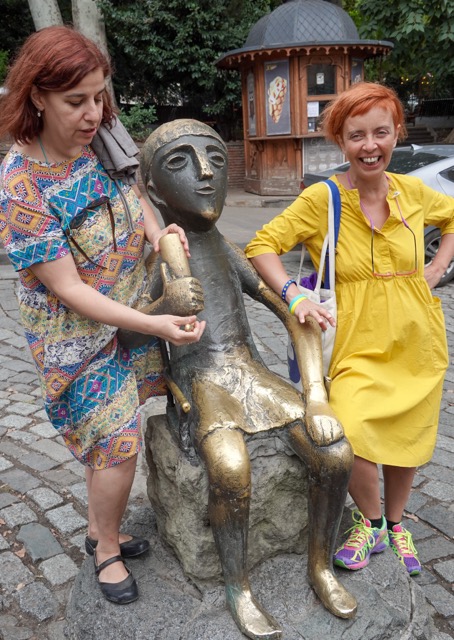
We had come to Georgia without much forethought or planning. We put our trust in the tour company (which we know well), checked the visa requirements, booked our airfare, and here we are. Now, after three days immersed in the culture, history, and politics of the region we are both thrilled to have made the journey, and more than a little terrified for this small, intensely proud country.
For thousands of years the area known today as Georgia has been like a highway between Asia and Europe for marauding armies. The Great Caucus Mountains form a massive barrier between the Arabian Peninsula and rest of Asia, creating a huge fertile valley bridging the Caspian and Black seas. Here sits Georgia, an agricultural gem in an irresistibly strategic location where world powers have left their boot tracks for millennia.
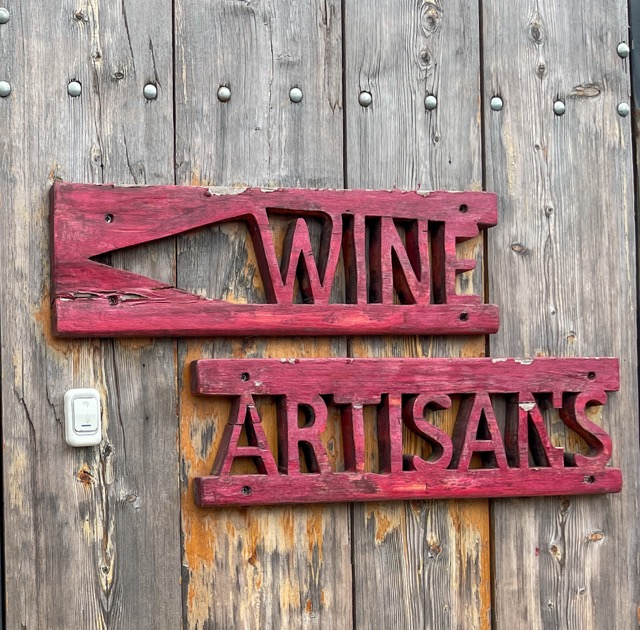
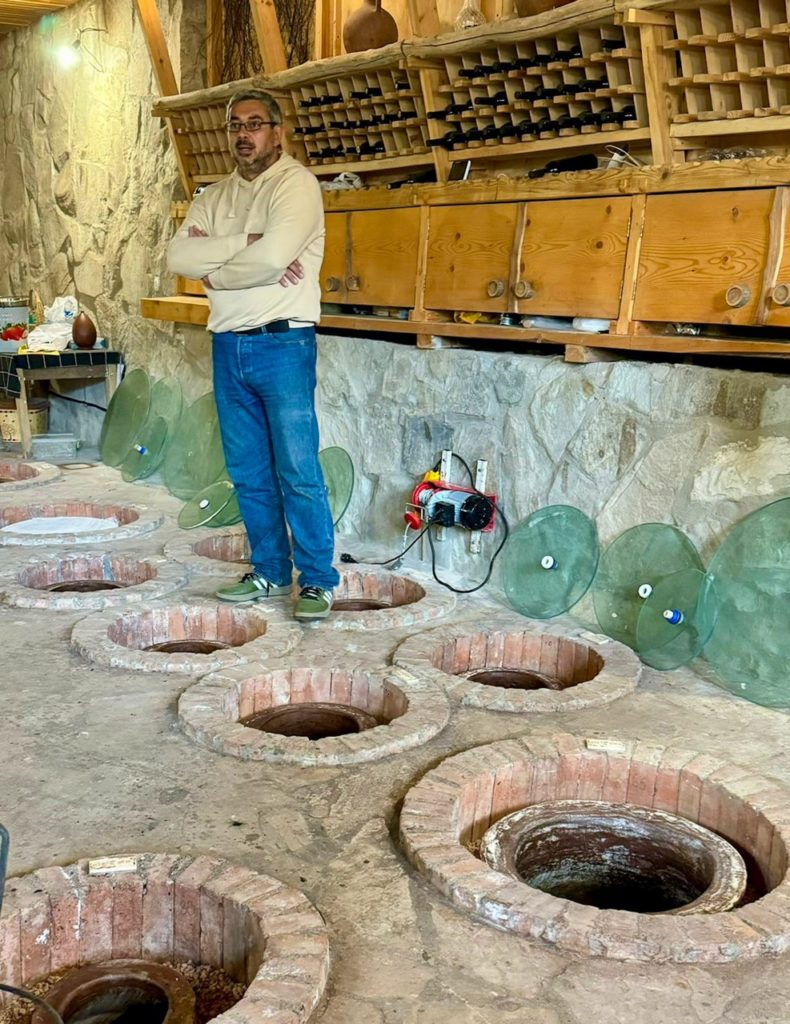
And so it goes today. In just the most recent century, Georgia was annexed by Czarist Russia (1891), declared independence during the Russian Revolution (1917), conquered by the Bolsheviks (1921), declared independence again with the fall of the Soviet empire (1991), and fought another war with Russia (2008). They were more or less enslaved by the Czar, Stalinized by the Soviets, endured severe economic punishment during “the dark 90’s”, and were cutoff from Russia as a trading partner following the 2008 war. Bonnie and I have lived most of our lives in an era where democratic principles were assumed to be sacred and permanent. Here in Georgia we have been introduced to a people who have rarely known any form of stability and who are once again facing the potential loss of their freedom to an autocracy. It is sobering.
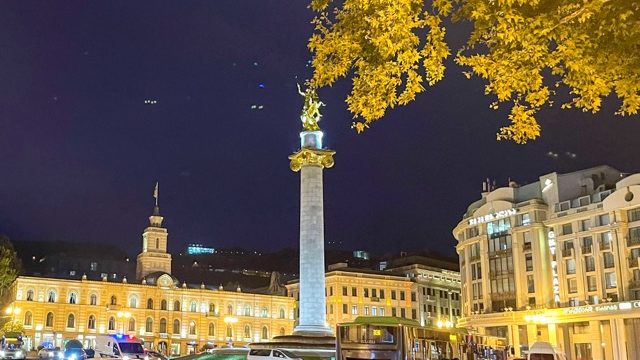
At dinner that evening, as the moon rose over the vineyards and another round of cha-cha was poured, our host began to open up on the current state of Georgian society. As it turns out, winemaking is a recently indulged passion. Prior to hosting naive westerners in his winery, this son of the Caucasus had risen through the officer ranks in the Georgian military, ultimately holding the post of Defense Minister in the previous government. That government was displaced by the current “Georgian Dream” (GD) in 2011. The GD, it turns out, is the fiefdom of Bidzina Ivanishvilli, a multi-billionaire with deep ties to Putin’s Russia, making wild promises and claims for the future purity and prosperity of Georgian society under his direction. So, while a huge majority of the people want desperately to continue developing a democratic system and to join the EU, the GD is actively moving to align the country with Putin’s autocracy. One of the GD’s tactics is to enlist the help of the country’s orthodox Christian church who are, of course, horrified by the evils of modern western culture. The most recent GD legislation (a law limiting foreign influence in Georgia politics, copied verbatim from Putin’s own law) brought the opposition into the streets by the tens of thousands resulting in daily confrontations with police and GD politicians.
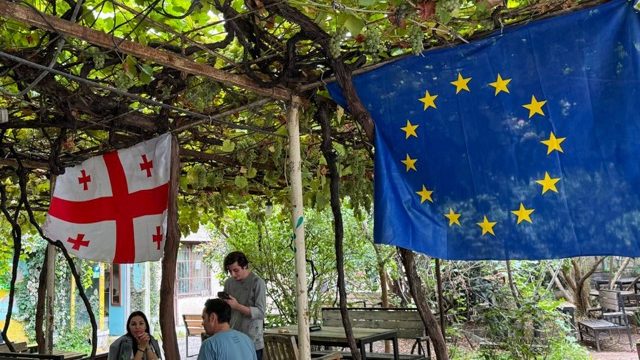

As the cha-cha flowed, and the toasts grew more personal, our new friends casually acknowledged their terror over their own future. Kristo, our redheaded pixie firebrand, explained that she had long ago crossed the line of safety from the regime, having led one protest after another and opening up the restaurant she owns with her husband as a haven for the opposition forces.
“I will be on the first page in the list of citizens to be arrested after the next election if we lose,” she stated flatly.
“We cannot win,” our host decreed, ruefully. “The election will be rigged by the GD. The passage of the foreign influence bill was designed to keep international monitoring of the election to a minimum. Without pressure from the world’s democracies, we are lost.”
Asked if he feared for his personal safety, his response was matter of fact. “Of course. It is a given. But this is my home. I will not leave it.” As he said this, I was struck again by the fierce intelligence behind those eyes, and the thought came for the first time that his career in politics might not quite be at an end in this charming winery.
As we hugged and said our goodbyes, that evening, we were flooded by a melange of feelings: gratitude for the warmth and hospitality of these amazing people, sadness and concern for the future of our new friends, satiated by the bounty of flavors, and sobered by the depth of the struggle represented in each traditional dish that had been put before us.
This night our casual decision to visit Georgia turned surreal. A mirror was held up before us, if we dared to look.
The Food
BY BONNIE NOBLE
Since we were in Georgia on a Culinary Backstreets tour, our entire week was focused on food and wine. We had so much to learn!
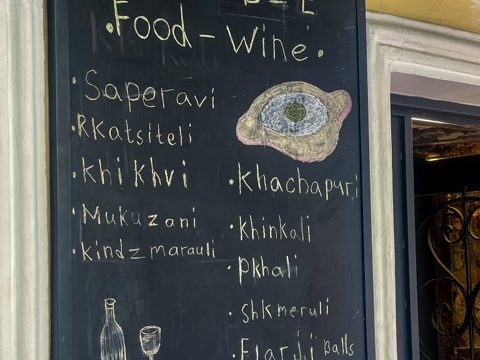
Georgian cuisine reflects the dramatic history of the country. Georgia’s location on the ancient Silk Road, at the crossroads of East and West, has resulted in a cuisine influenced by the Mediterranean, Arabs, Mongols, Persians, Ottomans, and even Northern India. Russian poet Alexander Pushkin asserted that “every Georgian dish is a poem” and I wonder if he was referring to the fusion of cultures as well as flavors on a Georgian plate.
Khachapuri
Probably the most traditional Georgian food, khachapuri translates as “cheesy bread” – a perfect description for this ubiquitous dish. Think flatbread made of leavened dough, filled with cheese. Nothing wrong with that combination. The dough is a little oily with a pleasantly crunchy exterior and a soft center; the cheese (usually cow “sulguni”) is smooth and salty. There are many local variations of khachapuri. Some have cheese just inside, others have cheese inside and on top. There are a khachapuri with minced meat and herbs, and one variety is stuffed with a paste made for kidney beans and sometimes a piece of bacon.
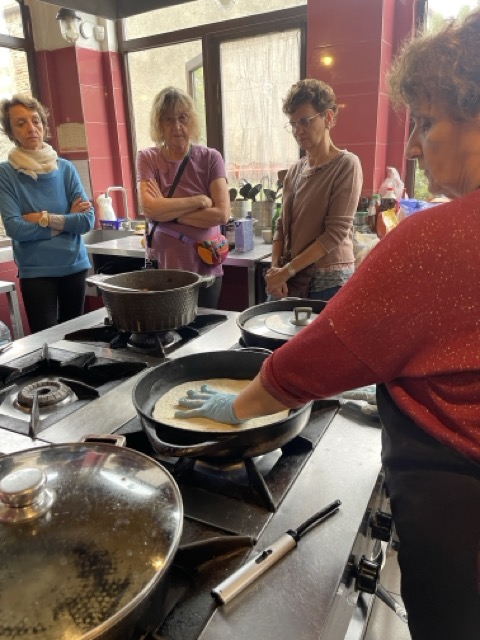
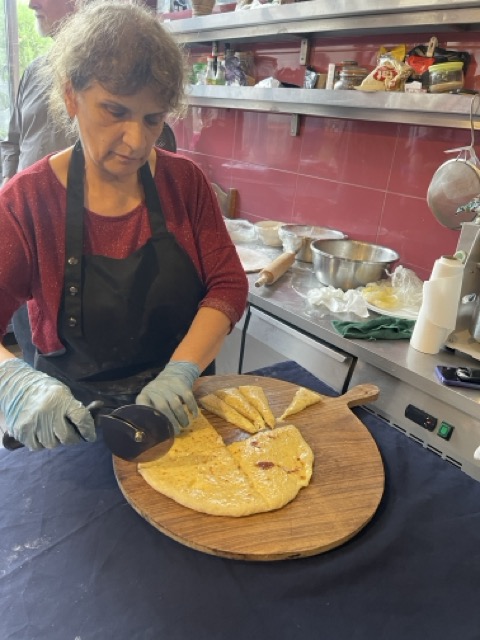
The most famous khachapuri is the Adjarian variation. This one resembles a boat (Adjari is a seaside region) with lots of cheese. An egg and a cube of butter are floated inside the moment it comes out of the oven. It is said that the egg yolk represents the sunset at sea. To eat an Adjarian khachapuri, you start by mixing the egg, butter, and cheese together and then tearing a piece of the baked dough from the outer corners to scoop up the gooey egg and cheese mixture. When the corners and sides of the boat are gone, you roll the bottom up and eat it.
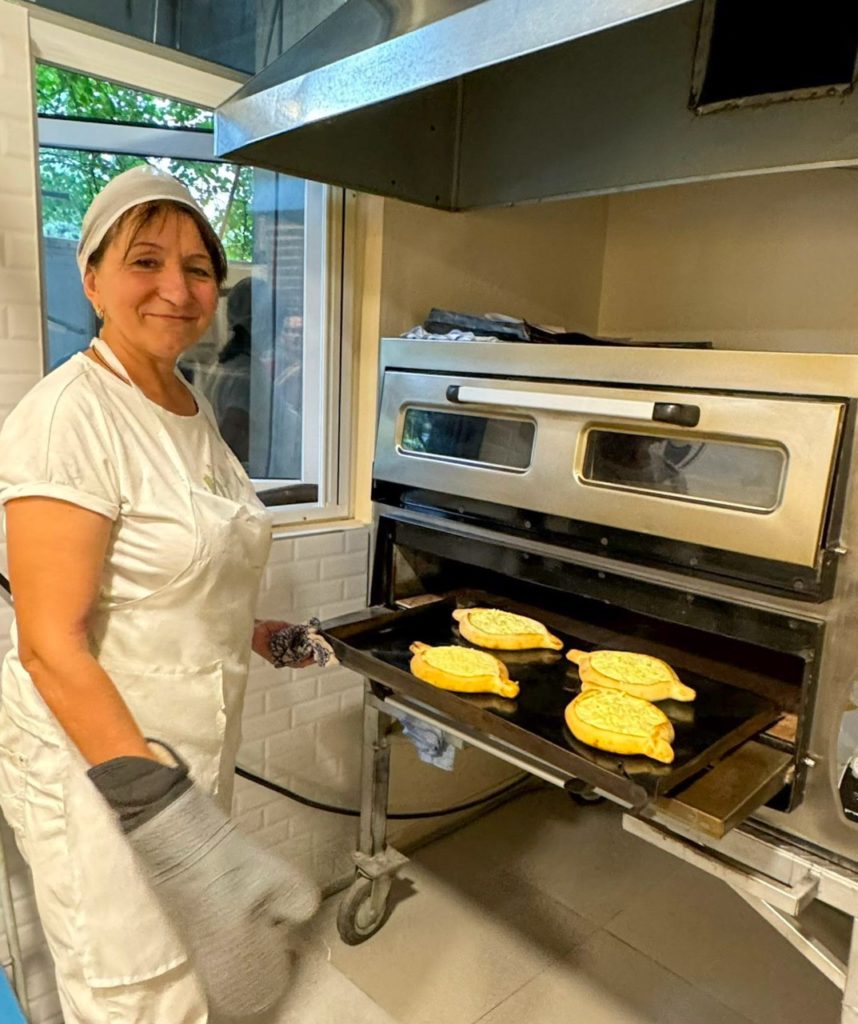
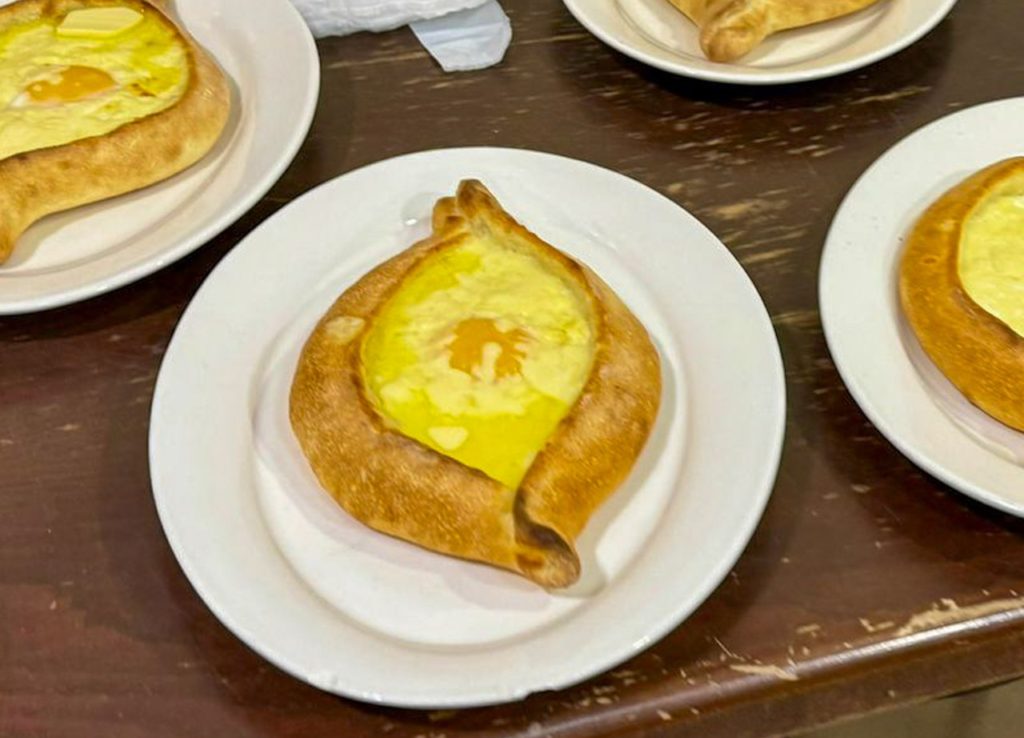
Khinkali
Another simple Georgian comfort food is a dumpling made with a variety of fillings including meat, potatoes, mushrooms, or cheese, depending on the region of Georgia you’re in. It is said that you can judge a good khinkali by the number of folds it has – fewer than 20 being considered substandard. Eating khinkali requires a sense of urgency and a specific technique. Most importantly, khinkali is finger food and the use of cutlery is considered rude. Here’s what you do: grab the dumpling from its topknot and bite a small hole in the side, tilt your head back to slurp out the broth, sink your teeth into the filling, place the topknot on your plate (so everybody can see who ate the most), take a swig or two of beer, repeat.
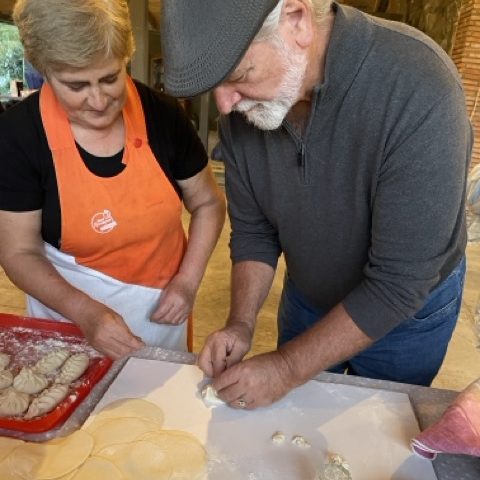
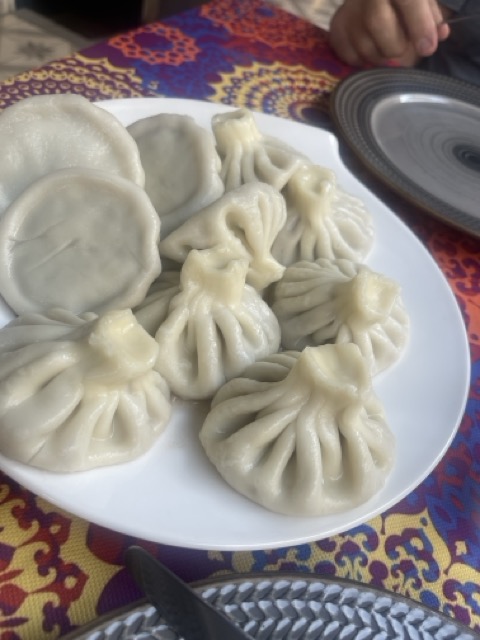
Nigvziani Badrijani
Eggplant with walnuts may not sound very interesting, but when slices of eggplant are grilled, covered in walnut paste, seasoned with ajika (a complex mix of several spices and herbs), and topped with pomegranate seeds the result is delicious. Various approaches to this Georgian classic were presented at every supra.
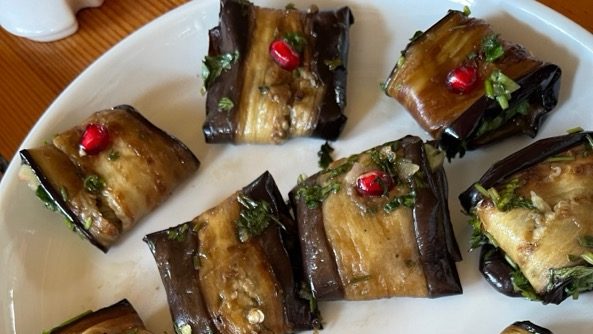
Cheese
More than 200 cheeses are produced in Georgia with each region making its own variety. The three most common are Sulgani, Guda, and Imeruli. Sulgani, a specialty of western Georgia, is a cow or buffalo milk semi-soft cheese with a high moisture content similar to mozzarella. Guda is a pungent sheep’s milk cheese from the mountains that is aged in sheepskin and Imeruli is a salty, semi-dry white goat’s milk cheese.
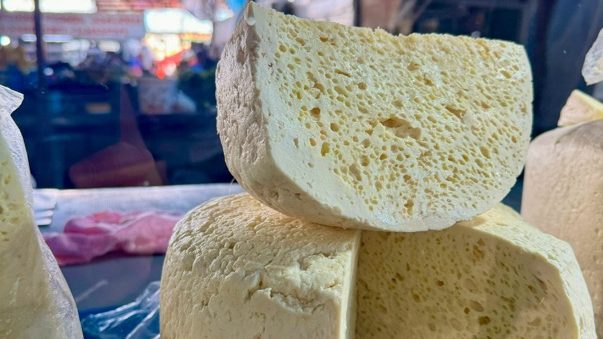
Churchkhela
When we opened our welcome bag provided by Culinary Backstreets, there was one item that stumped us. “What is this?” Ed asked. “Don’t know, a candle? Sausage?” I replied. Actually, it’s a lumpy, colorful confection that is hanging in storefront windows everywhere. It is also an example of preserved, portable nutrition created in response to the continuous conflict and uncertainty of Georgian life throughout history. The recipe: take some concentrated grape juice (left over from the wine harvest), add some honey and cook on high heat until it thickens; take your strands of walnuts threaded onto cotton string and dip them into the grape juice mixture; hang in the sun to dry. Churchkhela can be stored for several months, providing a simple storehouse of energy and protien for the soldier on the go. I’m thinking sliced churchkhela might be a nice addition to a cheese board.
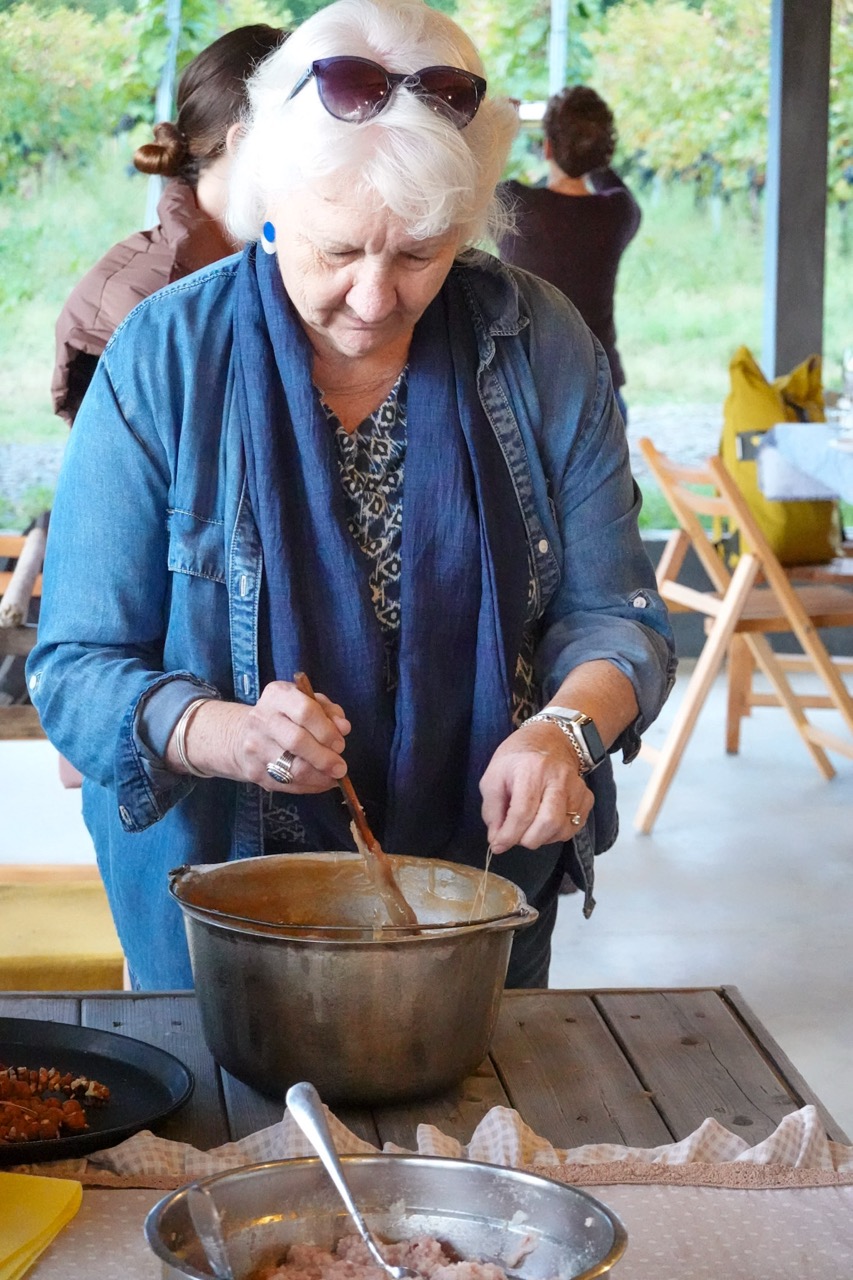
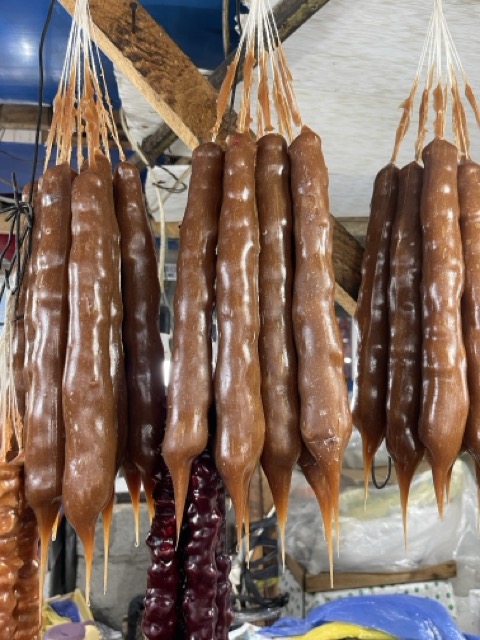
Tklapi
We had another “what is that?” conversation the first time we encountered tklapi. A placemat? Nope, it’s fruit leather: puréed fruit, spread thinly and sun-dried on a clothesline. There are sweet tklapi, like those made from fig or apricot, that make a terrific snack, and sour ones, intense with tart cherries and foraged plums, that are used in soups and stews. Here is another example of the preservation of food for uncertain times.
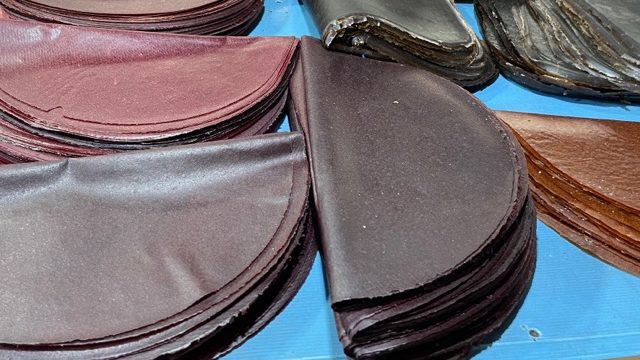
Jonjoli
Our third, “what in the world?” was a pickled and lightly fermented herby thing that we found on salads and served alongside various spreads. Jonjoli is made from the flowers and buds of a native deciduous shrub called Caucasian bladdernut. Georgians collect them and pickle them with salt and onion resulting in an interesting and quite pleasant taste. We’re not going to find this in Pennsylvania…or Valencia.
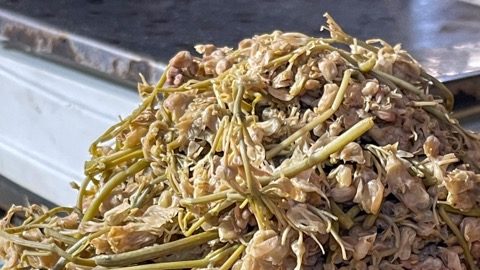
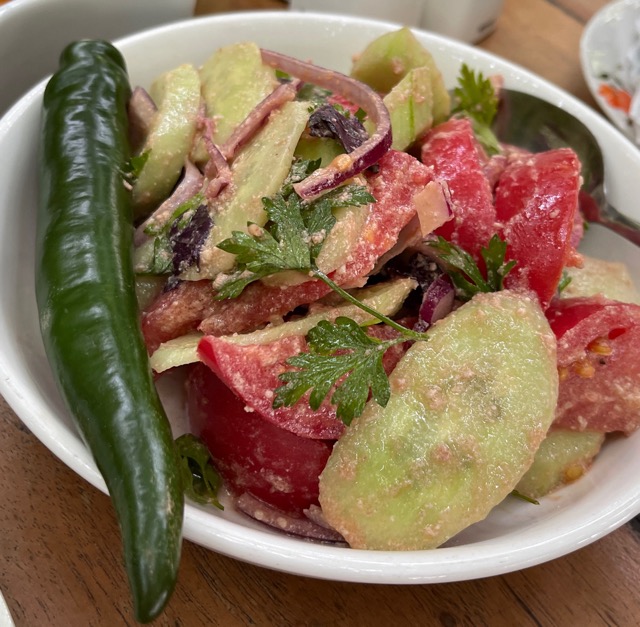
Tomato-cucumber salad
To prepare this traditional Georgian salad, cut cucumbers and tomatoes, add a few rings of red onion, parsley, and maybe some olives. That’s a Greek salad, right? Well, sort of. The Georgian version diverges in flavor with the use of sunflower or walnut oil rather than olive oil. However, the true appeal of this salad lies in ingredients. We’ve never eaten so many and such good tomatoes. I’m not sure if it’s the Georgian climate, the soil, or the specific variety of tomato, but they are special.
Pkhali and Mchadi
Every meal began with spreads of some sort. Pkhali, refers to an assortment of spreads or pâtés made from whatever vegetable is on hand (our favorite was beet). Easy to make, these delicious spreads involve boiling and shredding the vegetable and then adding a squeeze of lemon juice, minced garlic, a handful each of cilantro and ground walnuts (Georgian cooks put walnuts in almost everything!). Top with pomegranate seeds and enjoy along with mchadi – small crispy loaves of corn flour, milk and water that is cooked in a skillet on the stove top and often served with cheese.
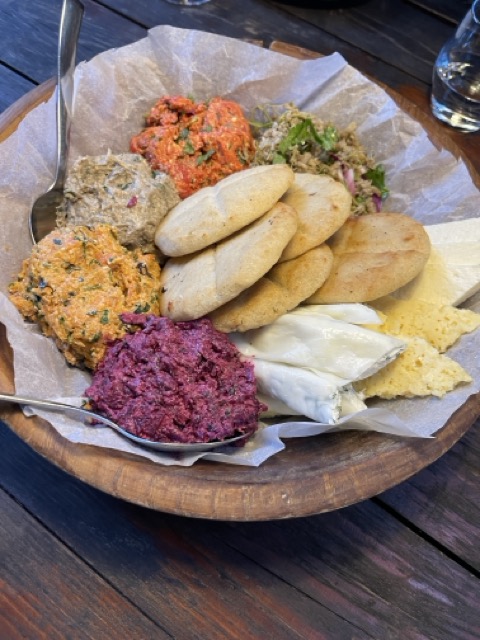
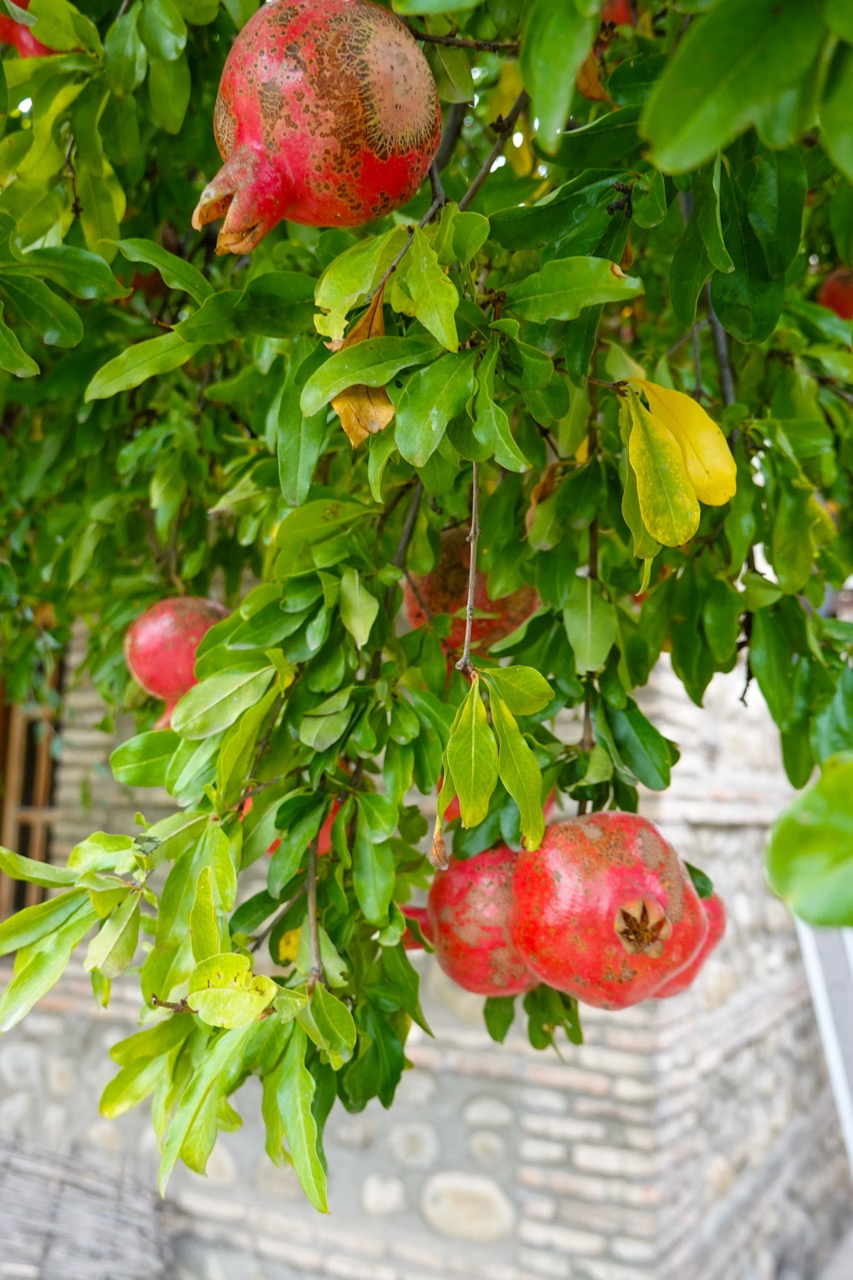
Mchadi are also served with lobio – a deliciously thick kidney bean soup achieved by pounding slow-cooked beans in a mortar and pestle before mixing with fried onions, cilantro, vinegar, dried marigold, and chiles is stirred into the pot just before serving. Amazing.
Puri
No blog post about Georgian cuisine would be complete without referencing the local bread. Puri is prepared in a wood fire oven known as a tonne (something like an Indian tandoor). To bake puri, the baker slaps the raw dough against the wall of the tonne and uses iron skewers to get the fresh bread out of the hot oven when it’s done.
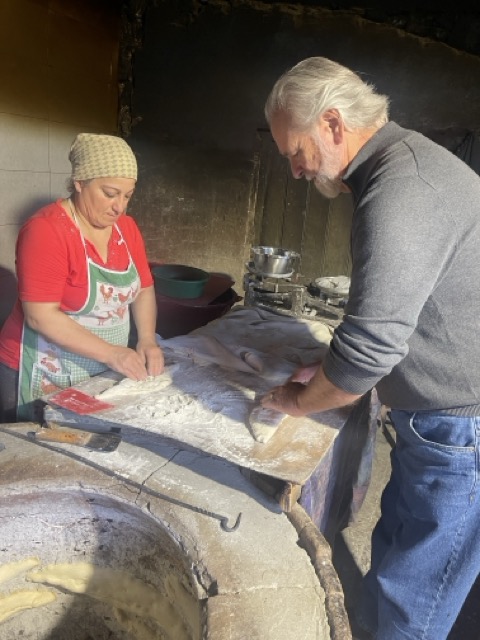
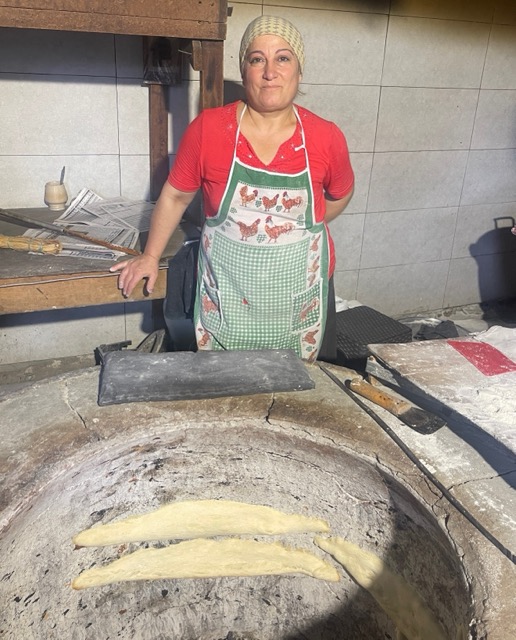
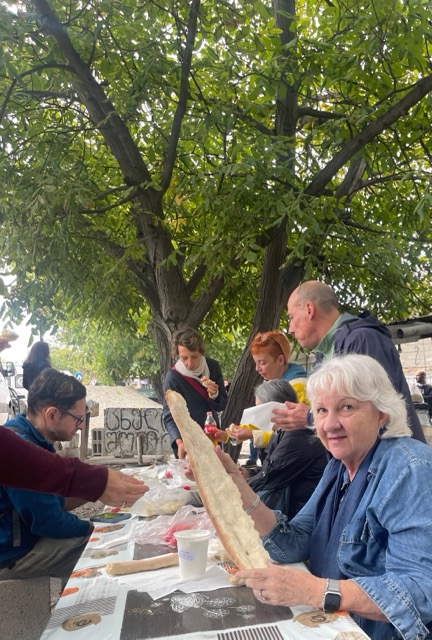
Tkemali
Every supra included a dish of tkemali (sour plum sauce). This zesty, sour sauce made from small green unripe plums that are prevalent in Georgia. Other plums can be used, as long as they’re not overripe—their skins contain enough acidity to give the sauce its characteristic tang. Tkemali is used as a condiment for fried or grilled meat, poultry and potatoes – Georgian ketchup!
THE Wine
by Ed Noble
So, what about the wine? As so often happens in our travels, we planned to visit Tbilisi primarily to explore the history of winemaking in the country, only to discover far more compelling stories around culture, politics, and tradition. To this end we travel. To be clear, however, you cannot understand Georgia without exploring its wines. Winemaking in Georgia literally predates history. The archaeological evidence provides proof that Georgia has been fermenting grapes into wine for at least 8,000 years, making it the true birthplace of winemaking. As we traveled around the region the importance of viticulture to the history and identity of Georgians was evidenced in carvings of grapes and winemaking on the facades of churches built more than a thousand years ago and in the excavated winery we visited that dates to the 4th century. Like everything about Georgia, however, the modern story of wine is convoluted.
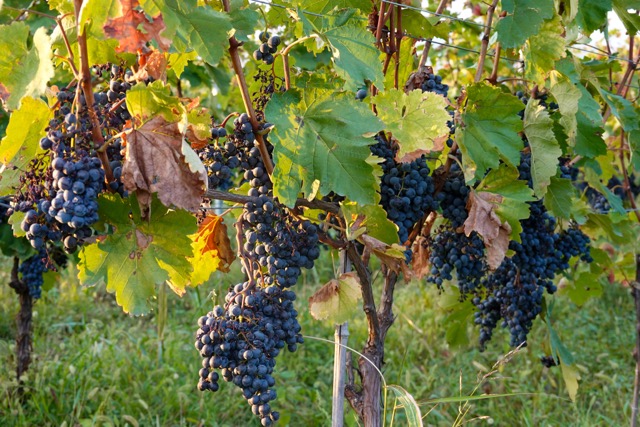

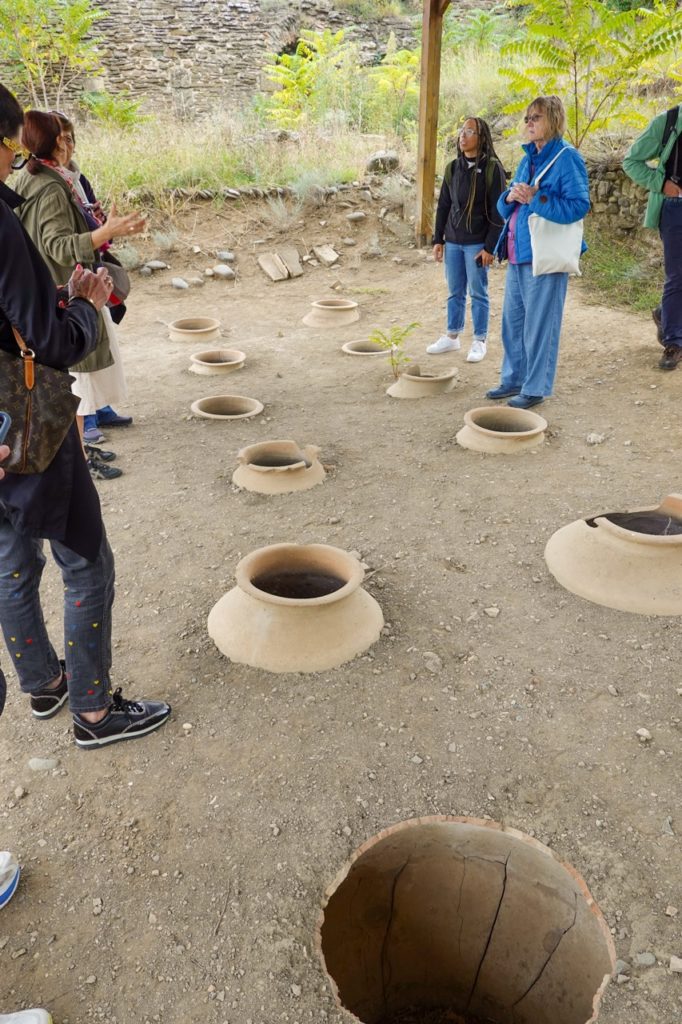
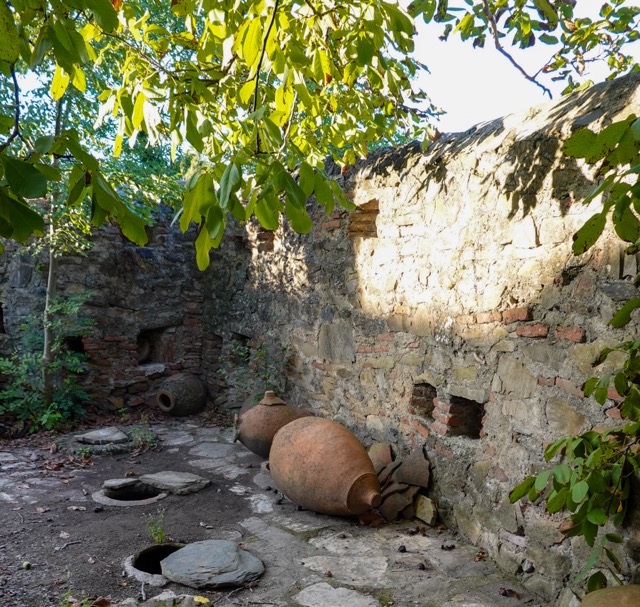
First, let me explain some of what makes Georgian wine unique. It starts with the fermenting vessels. Georgian wine from 8,000 years ago till today is made in traditional clay jars called qvevri (pronounced kwev-ree). These are enormous egg shaped pots that are made today by specialized artisans using the local clays in a tradition that goes back millennia. The qvevri are baked in enormous wood-fired kilns at temperatures approaching 2,000 degrees Fahrenheit for as long as a week. At the winery, they are buried in the Georgian soil where the temperature moderating effect of the earth optimizes the conditions for winemaking. When a Georgian winemaker shows you his wine cellar, it is to the room where the qvevri are buried that you will be directed. This is the heart of the Georgian winemaking process. The grapes are pressed and the juice placed, along with the skins and pulp, into the buried qvevri to ferment. In most cases, the juice is left in contact with the skins for the entire fermentation resulting in a white wine with a distinctly amber color and a startlingly tannic profile. At first it was quite disorienting to take a sip of this innocent looking straw colored wine and experience mouth puckering tannins. We adapted, however.
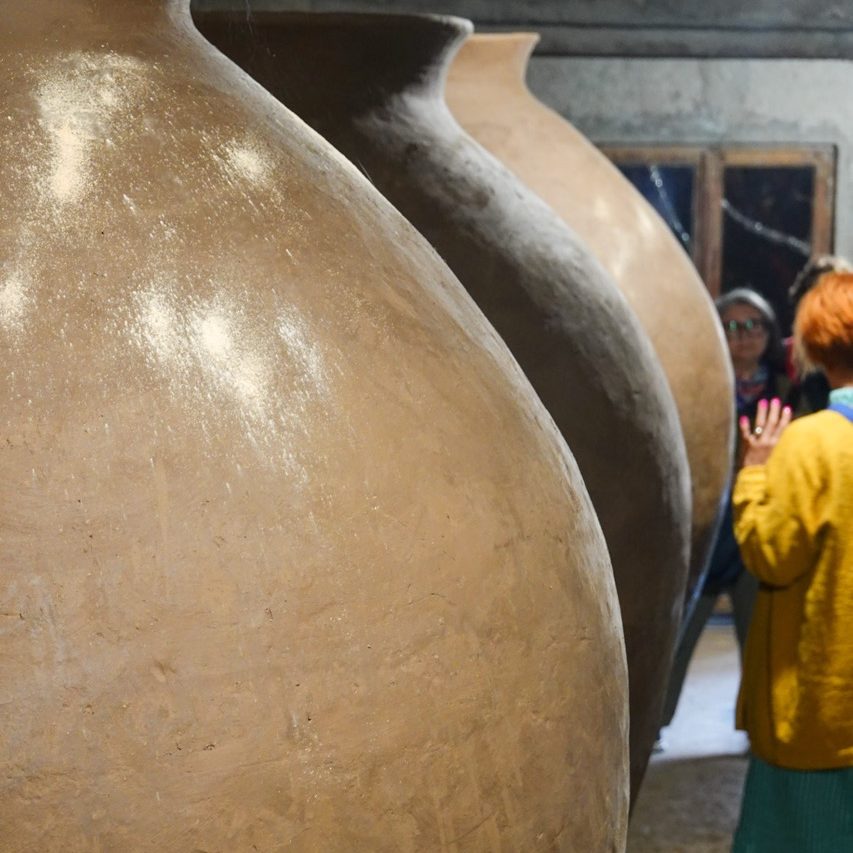
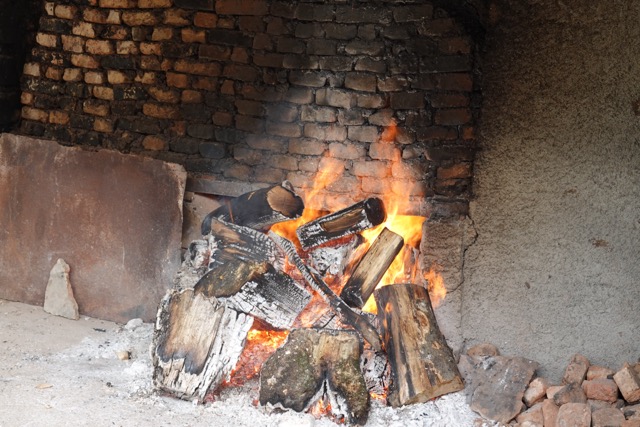
Once the winemaker deems the fermentation process complete, the wine is pumped from the qvevri into stainless steel vessels, and from this point to bottling the process looks quite familiar to western eyes. Modern Georgian winemakers are quite adamant that their wines remain totally organic and natural. No chemicals are used either in the vineyards or in the winemaking. This can result in significant variability from one vintage to the next, and these wines are made to be drunk fresh, not aged. The result is that tasting and enjoying wine is an endless adventure with each new bottle providing interesting variations. In the course of a week we must have sampled 60 – 70 different wines, primarily whites (amber) with a handful of reds served late in a meal. No two were alike. Some of the primary grapes became familiar, but the resulting wine was always unique and enjoyable.
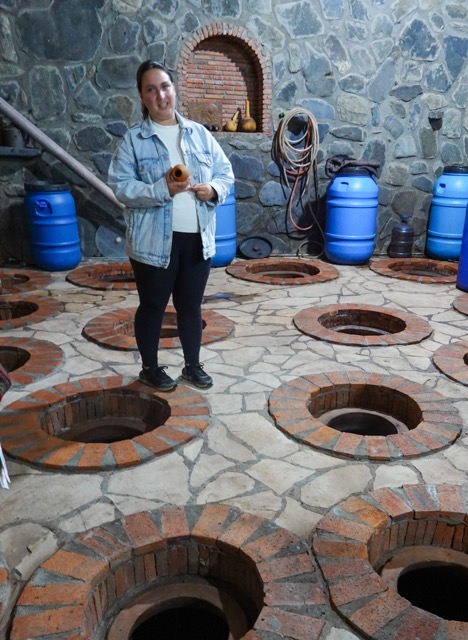
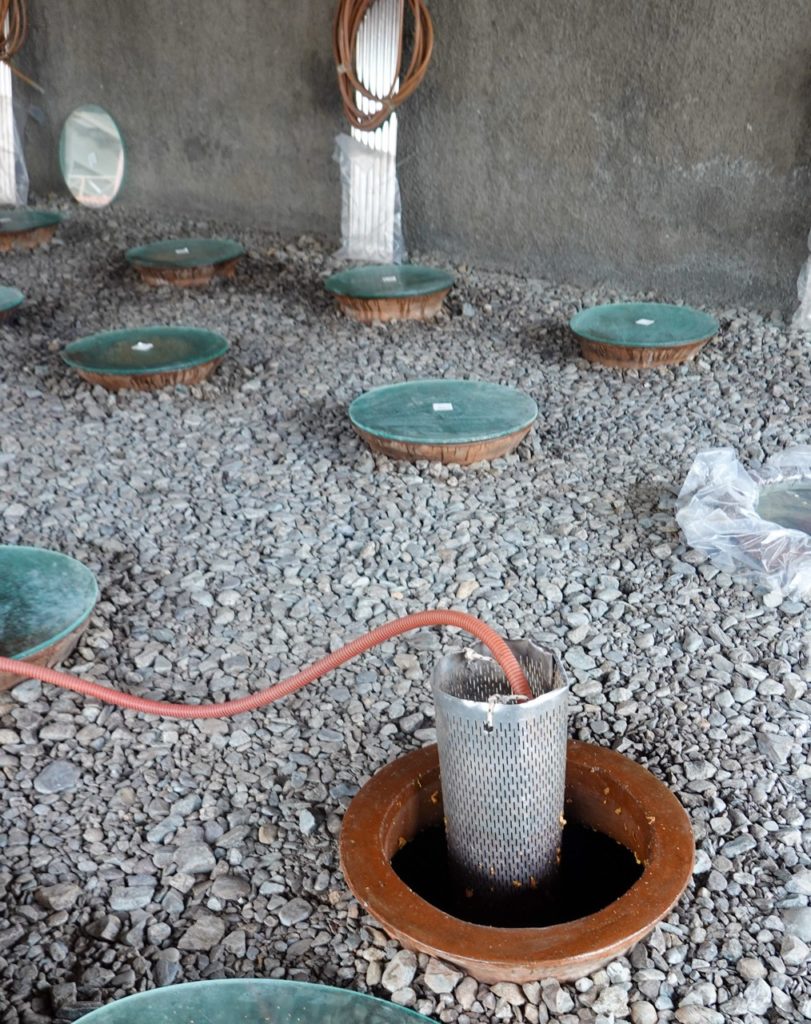
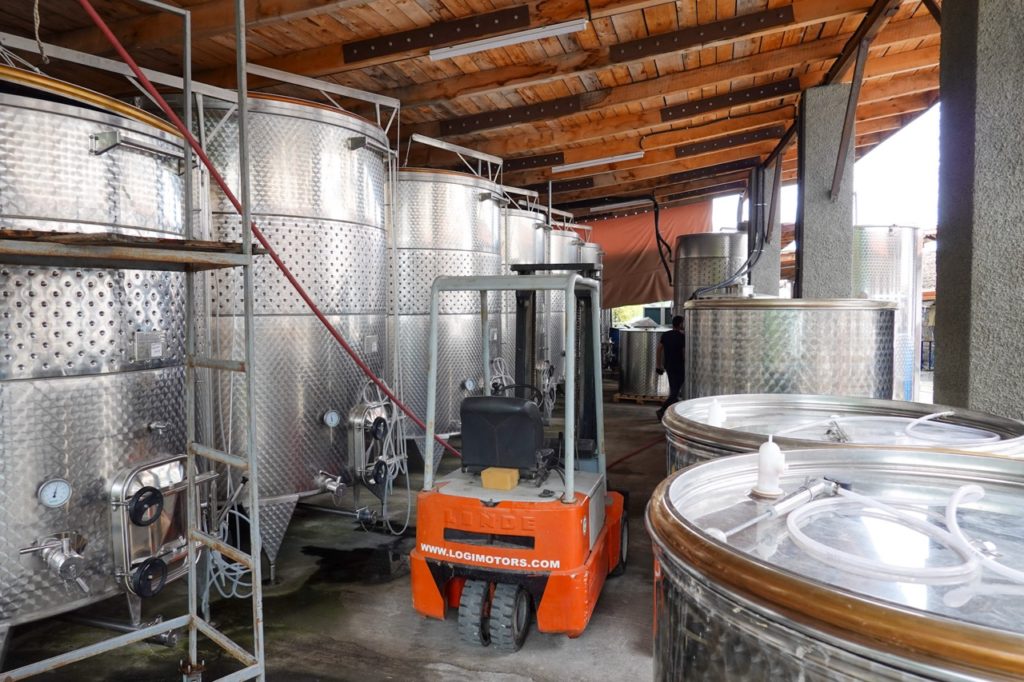
Despite the deep tradition this winemaking represents, however, the modern version is a fledgling industry attempting to recover its place in the world. You see, as with all things in modern Georgian, you cannot escape the impact of the Soviet era. When the Soviets took over the country in 1921, they proceeded to mold the production of wine into a beverage for the people – quantity, not quality. The historic vineyards with their hundreds of grape varieties were ripped out and replaced with the most productive grapes to maximize volume. The qvevri tradition was replaced by industrial scale wineries and production maximized by the addition of water and sugar. For 70 years, this was Georgian wine. The collapse of the Soviet Union did not immediately restore the old ways. After all, three generations of winemakers had known no other system and their only market was Russia. It wasn’t until the 2008 war when, to punish Georgia, Putin cutoff all trade between the countries. Suddenly, the market for the sweet, watery, Soviet era wine disappeared and a new generation began to look around for another model. They rediscovered their own tradition.

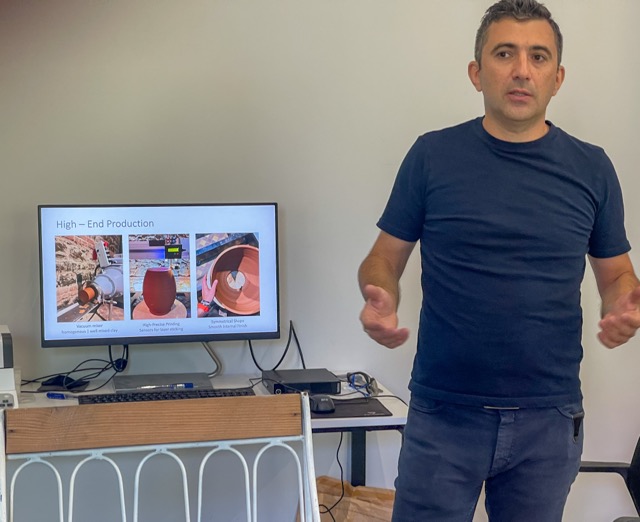
The farmers and vintners we met are the courageous vanguard of a revival that is finding its feet. We toured a “library” vineyard planted with over 450 grape varieties from Georgia’s past aimed at preserving the lineage. We met an entrepreneur who has designed and built a 3-D printer to produce qvevri of a quality and on scale that will meet the growing demands of the wine industry. But, most of all, we enjoyed the passion and zeal these pioneers expressed for their country and the grapes that have defined it for thousands of years.
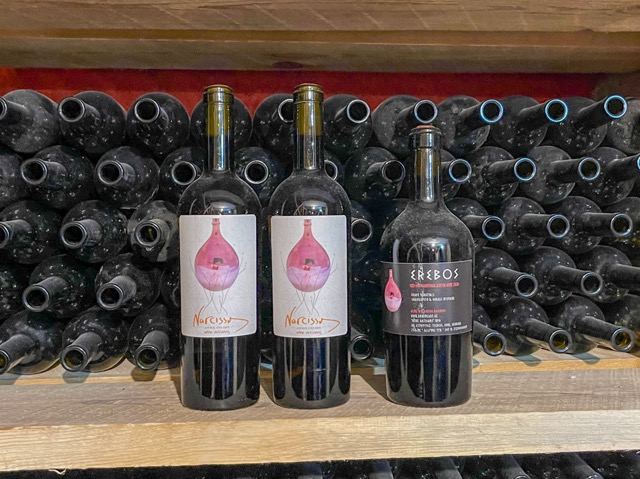
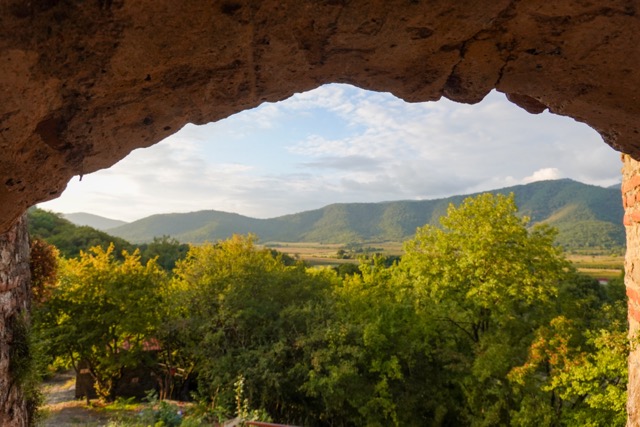
Another memorable anniversary
We were delighted to celebrate our 51st wedding anniversary in Georgia.
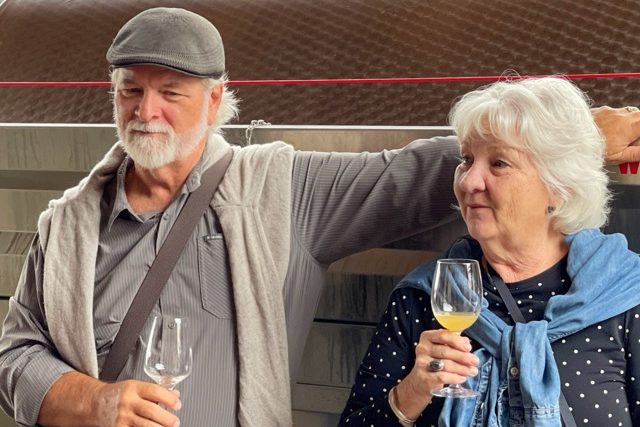
About Us
Welcome to our little corner of the world where we invite you to embark on exciting journeys with us!
We’re Ed and Bonnie, a duo passionate about exploring the world and experiencing its wonders. Our love for travel isn’t just about discovering new places; it’s about sharing those moments with cherished family and friends like you.
Our hope is that you will feel like you’re right there with us, sharing in the excitement and wonder of each destination. Better yet, let’s plan a rendezvous somewhere wonderful! Learn more

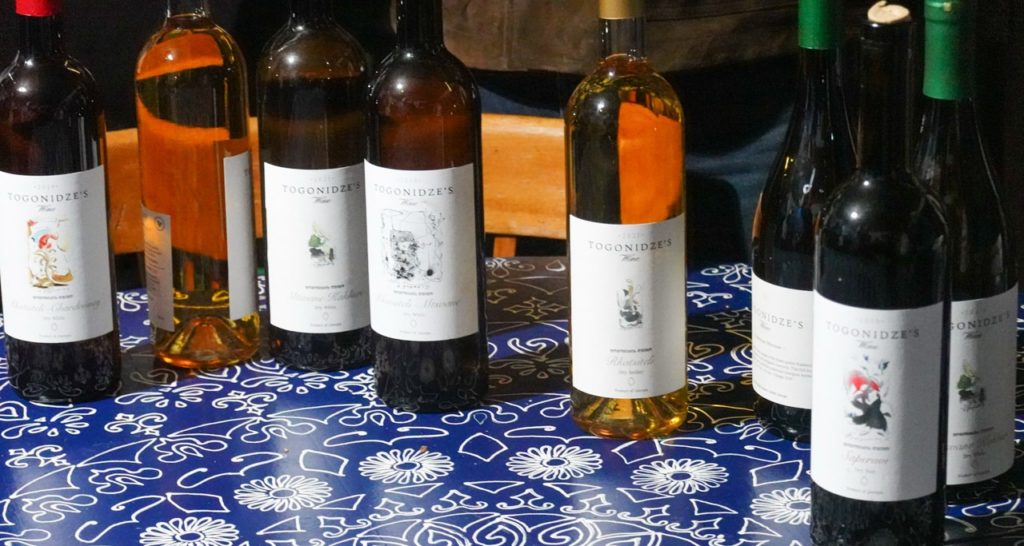
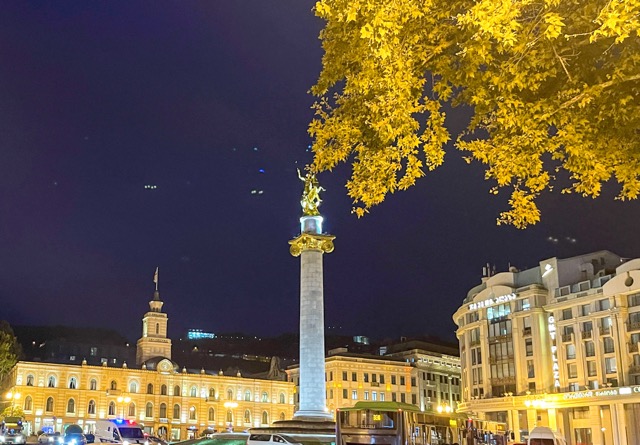
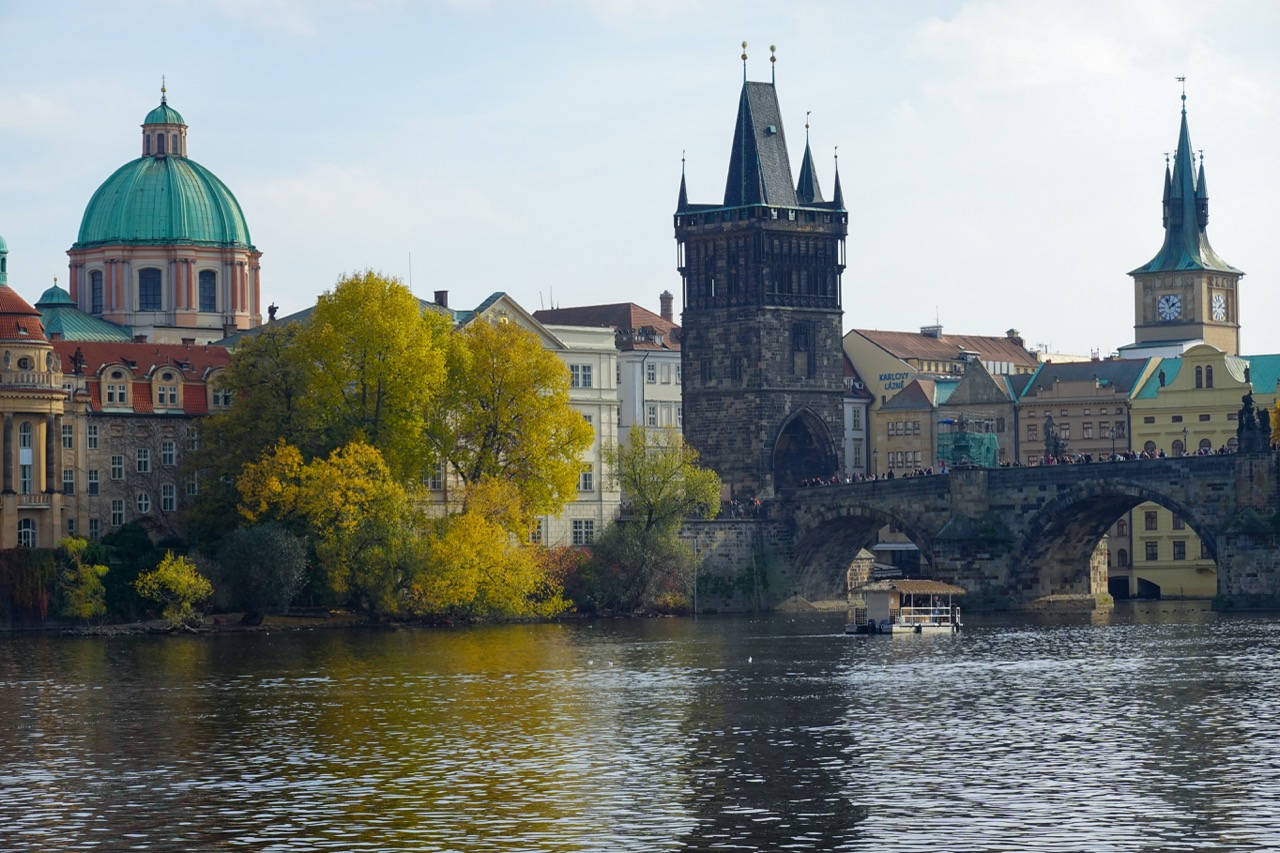
What a singularly Incredible experience and education you have given us here–Who Knew!?! The exotic and earthy food, the history of wines made from giant buried quevri, the heroic and seriously endangered Georgians–Rick Steves would So Approve of your quantum learning and ambassadorship! And Thanks for the marvelous photos that make it all so Real for those of us traveling with you Vicariously! WOW. Jo (and Nayan)
Sharing your blogs with Angela, Elli, Toni and Quentin!
Nayan comments that you both write like professionals. True!!
You’re too kind, Jo, but thank you. It was an eye opener for us. We are so concerned for our new Tbilisi friends. And, I’m sure I don’t have to spell out how important our own election is to the future of Georgia as well.
food and drink and new adventures…such a colorful and fun trip. Don’t know how you two survive it all. expansion into new tastes, new cultures and new friends.